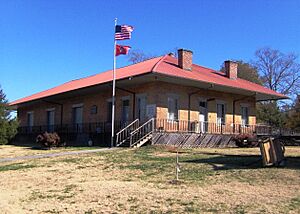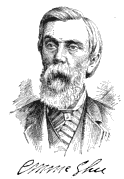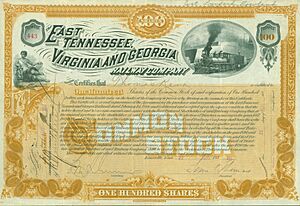East Tennessee, Virginia and Georgia Railway facts for kids

1890 map of the East Tennessee, Virginia and Georgia Railway
|
|
| Overview | |
|---|---|
| Locale | Southeastern United States |
| Dates of operation | 1869–1894 |
| Predecessor | East Tennessee and Virginia Railroad East Tennessee and Georgia Railroad |
| Successor | Southern Railway |
| Technical | |
| Track gauge | 4 ft 8 1⁄2 in (1,435 mm) standard gauge |
| Previous gauge | 5 ft (1,524 mm) American Civil War era and converted to 4 ft 9 in (1,448 mm) in 1886 |
The East Tennessee, Virginia and Georgia Railroad (ETV&G) was a big railroad company in the southeastern United States. It operated in the late 1800s. This railroad was formed in 1869 when two smaller lines, the East Tennessee and Virginia Railroad and the East Tennessee and Georgia Railroad, joined together.
The ETV&G was very important for connecting East Tennessee and other isolated parts of the Southern Appalachia region to the rest of the country. It also helped make Knoxville a major trading hub. In 1894, the ETV&G merged with another railroad, the Richmond and Danville Railroad, to create the Southern Railway.
Even though people wanted a railroad in East Tennessee as early as the 1830s, money problems stopped construction for a while. The East Tennessee and Georgia Railroad was built between 1847 and 1859, connecting Knoxville, Tennessee with Dalton, Georgia. The East Tennessee and Virginia Railroad was built from 1850 to 1856, linking Knoxville with Bristol, Tennessee. In 1869, a businessman from Knoxville named Charles McClung McGhee led a group that bought both lines. They combined them to form the ETV&G. Thanks to McGhee's efforts, the new ETV&G bought many other rail lines across the region. By 1890, the ETV&G controlled over 2,500 miles (4,000 km) of tracks in five states!
Contents
Building the First Railroads
For a long time, East Tennessee faced economic challenges because of its natural barriers. These were the Blue Ridge Mountains to the south and east, and the Cumberland Plateau to the north and west. These mountains made it hard to transport goods and connect with other areas.
Early Ideas for Rail Lines
After railroads started becoming popular in the 1820s, business leaders in East Tennessee began talking about building their own lines. They hoped this would help solve their isolation problem. In the mid-1830s, some businessmen, including a doctor from Knoxville named J. G. M. Ramsey, planned a railroad. It would connect Cincinnati and Charleston, passing through East Tennessee. However, a financial crisis in 1837, called the Panic of 1837, stopped this plan.
In 1836, a group of businessmen started the Hiwassee Railroad company in Athens, Tennessee. Their goal was to build a line from Knoxville south to Dalton, Georgia. In Dalton, it would connect with a planned extension of the Charleston and Hamburg line. This would give Knoxville a link to the Atlantic Coast. But like other early railroad projects, the Hiwassee company also faced money problems and almost failed. To survive, they had to focus on building roads and making iron instead.

The East Tennessee and Georgia Railroad
By 1844, the Charleston and Hamburg extension reached Dalton. This made businessmen in Knoxville and Athens excited again about building a rail line to Georgia. The Hiwassee Company was re-established in 1847 as the East Tennessee and Georgia Railroad. With new support from the Tennessee state government, work on the line began the next year.
By 1852, the tracks reached Blair's Ferry, which is now Loudon, Tennessee, just southwest of Knoxville. On June 22, 1855, the very first train arrived in Knoxville using the East Tennessee and Georgia's tracks.
The East Tennessee and Virginia Railroad
On July 4, 1855, as people in Knoxville celebrated the arrival of the railroad, work began on another line. This was the East Tennessee and Virginia Railroad. It aimed to connect Knoxville with Bristol, Tennessee. From Bristol, it would link to existing tracks, creating a continuous rail line from New York all the way to Memphis.
Under the leadership of Samuel B. Cunningham, a doctor from Jonesborough, this line reached New Market in 1856. After overcoming financial and engineering challenges, the tracks from Knoxville to Bristol were finished on May 14, 1858. Cunningham himself drove in the very last spike.
Connecting Northward
During the 1850s, almost every important business and political leader in Knoxville was involved in building railroads. In 1852, several important people, including congressmen and lawyers, started the Knoxville and Kentucky Railroad. This company planned to build a line north into Kentucky. There, it would connect with existing lines to Cincinnati and Louisville. However, when the Civil War began, this company had only laid about nine miles of track.
Railroads During the Civil War
The railroads in East Tennessee were a very important way to move supplies between Virginia and the Deep South. Because of this, both the Confederate and Union armies saw the region as vital. On November 8, 1861, Union supporters in East Tennessee destroyed five railroad bridges. This forced the Confederate government to declare martial law, meaning the military took control of the area. Throughout the war, both sides destroyed railroad tracks and facilities. They did this to stop the other side from using them.
The ETV&G Grows and Changes
After the Civil War, a Knoxville businessman named Charles McClung McGhee (1828–1907) and other investors formed a group. They bought both the East Tennessee and Georgia Railroad and the East Tennessee and Virginia Railroad. In 1869, these two lines were combined to create the East Tennessee, Virginia and Georgia Railroad. Thomas Howard Callaway became its president.
McGhee was good at connecting northern investors with local interests. This helped the ETV&G get a lot of money, and the new company grew very quickly.
Expanding Across the South
In 1869, the ETV&G bought the Knoxville and Kentucky Railroad, which had started up again after the war. Over the next ten years, the ETV&G extended its tracks to the Kentucky state line at Jellico. During this same time, the ETV&G also bought other important railroads. These included:
- The Memphis and Charleston Railroad, which connected Memphis and Chattanooga.
- The Georgia Southern Railroad, which connected Dalton with Rome, Georgia.
- The Macon and Brunswick Railroad, which connected Macon, Georgia, with Brunswick, Georgia on the Atlantic Coast.
By 1882, the ETV&G had finished tracks from Rome to Macon, connecting these last two lines.
In the early 1880s, the ETV&G managed to build a line through the tough French Broad valley. This was along the Tennessee-North Carolina state line. It created a direct link from Knoxville to Asheville. The company also built a line connecting its tracks at Clinton with the Cincinnati Southern Railway tracks at Harriman. By 1890, the ETV&G controlled 2,500 miles (4,000 km) of tracks. These tracks reached as far south as Meridian, Mississippi, and Mobile, Alabama, west to Memphis, and east to Brunswick.
Changes and New Ownership
In the mid-1880s, too much spending on railroad construction started to hurt the ETV&G's money situation. In 1886, the company was reorganized and became the East Tennessee, Virginia and Georgia Railway (changing from "Railroad"). Eventually, it came under the control of a large company called Richmond Terminal Company.
After Richmond Terminal collapsed in the early 1890s, a New York financier named J. P. Morgan created a new company called the Southern Railway. The Southern Railway bought the ETV&G and the Richmond and Danville Railroad. These two companies were combined in 1894. Later, in 1982, the Southern Railway was bought by the Norfolk Southern Corporation. Today, Norfolk Southern manages most of the old ETV&G system.




